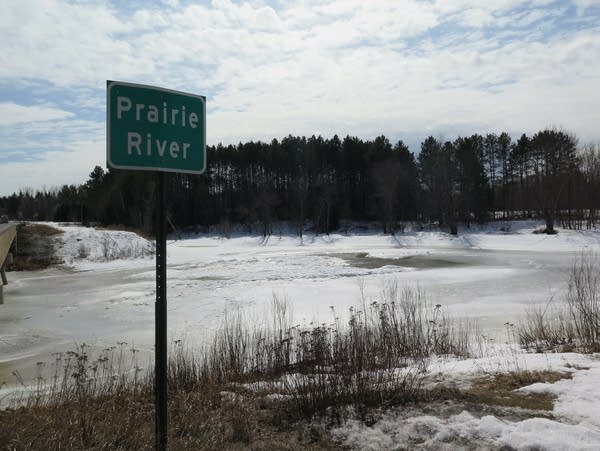Thirty years ago Wednesday, on March 3, 1991, the Line 3 oil pipeline ruptured in Grand Rapids, Minn., spilling 1.7 million gallons of crude oil onto the frozen Prairie River.
It's still the largest inland oil spill in U.S. history.
Because the river was covered with ice, crews were able to keep the oil from reaching the Mississippi, 2 miles away.
"There would be people on the ice, squeegeeing oil on top of the ice, which was weird, everything was weird, it was like some kind of gross landscape,” Scott Hall, a reporter for Grand Rapids public radio station KAXE, told MPR News in 2018 for an episode of its Rivers of Oil podcast, which dove deep into the impacts of the spill.
“And so they had hoses going down, and just sucking as much oil as they could out into these tanker trucks."

About 50 people gathered at the Prairie River on the 30th anniversary of the largest inland oil spill in U.S. history. On March 3, 1991, a pipeline owned by the Lakehead Pipeline Co. ruptured, spilling about 1.7 million gallons of crude oil.
Kirsti Marohn | MPR News
The Lakehead Pipeline Co. owned Line 3, which was built in the 1960s to carry oil from Canada, at the time of the spill. And the company that succeeded Lakehead, Enbridge Energy, is now replacing that same Line 3 with a new pipeline along a different route across the state.
Construction on the new line began in earnest in December. But Native American tribes and environmental groups continue to fight the $4 billion project, on the ground and in court.
About 50 people gathered at the Prairie River near the spill site in Grand Rapids Wednesday.
Protesters say the 1991 spill is an indicator of the risk that oil pipelines pose to Minnesota waters.
Enbridge argues that the aging Line 3 needs to be replaced, and improvements in monitoring technology and operations in the past 30 years have greatly improved safety.
Rivers of Oil is a podcast produced by MPR News in 2018. It’s a look at how the pipelines beneath our feet, from Keystone XL to Dakota Access to Line 3, have come to the forefront of an epic tug of war between reliance and risk — and how we all have a role to play in this story.
Below is an excerpt from the podcast’s second episode, with begins at the site of the 1991 Grand Rapids oil spill. Listen to the full episode, and find related reading, here.
Listen and subscribe to Rivers of Oil on your mobile device: Apple Podcasts | NPR One | TuneIn| RadioPublic | iHeartRadio | RSS

It took years to clean up after an oil pipeline burst, gushing 1.7 million gallons of crude onto the landscape near Grand Rapids, in 1991. Here, crews clean up along on an area river -- a week after the spill.
Screengrab from video shot by Harry Hutchins
Harry Hutchins had grand hopes for a 16-acre patch of land near a community college in Grand Rapids, Minn.
It was the late 1980s, and Hutchins was a teacher at the school. He wanted to return the plot from farmland back to its natural wetland state. The idea was to use the marsh as a sort of living laboratory for his students.
It took two years of work, but Hutchins finally got approval to make the plot a wetland again.
Then, on March 3, 1991: A phone call. "A friend of mine, he called me up and said, 'Harry you won't believe this, but your wetland is filled with oil,'" Hutchins recalled this year.
A pipeline rupture had gushed 1.7 million gallons of crude oil across the landscape, filling Hutchins' wetland with the black mess.
"It just covered these aspen trees, because it went up 30, 40 feet," he recalled. "It was quite a geyser."
It remains the largest inland oil spill in U.S. history.
The pipe that ruptured was Enbridge Energy's Line 3, which carries crude oil across northern Minnesota. Today, Enbridge is building a new Line 3 along a different route across the state, and its plan is prompting vigorous debate — partly focused on the fear of spills.
Perspective is everything: The energy industry points out that nearly all the oil transported in pipelines reaches its destination safely. From the industry's point of view, 99.999 percent of the oil they transport is transported safely.
But that leaves the other .001 percent. And that's the percentage that people in areas where pipes have leaked care about.
This story isn't just about the risks of transporting huge amounts of oil through pipelines. It's also about the reward that oil provides. Because cheap, easy access to oil powers our society in ways we don't even think about. It's not just in our gas tanks — it's in the roads we drive on, our kids' plastic toys, our makeup.
In this episode of Rivers of Oil, we examine the fear of spills from oil pipelines, through the lens of the fight over Line 3, the plan that has the potential to be the next place where we see mass protests over pipelines.
As people who are fighting Line 3 like to point out, oil, and water — they don't mix. Listen to the full episode.
You make MPR News possible. Individual donations are behind the clarity in coverage from our reporters across the state, stories that connect us, and conversations that provide perspectives. Help ensure MPR remains a resource that brings Minnesotans together.
"Oil" - Google News
March 04, 2021 at 06:22AM
https://ift.tt/3kJTAEf
30 years later, echoes of largest inland oil spill remain in Line 3 fight - Minnesota Public Radio News
"Oil" - Google News
https://ift.tt/2SukWkJ
https://ift.tt/3fcD5NP
Bagikan Berita Ini

















0 Response to "30 years later, echoes of largest inland oil spill remain in Line 3 fight - Minnesota Public Radio News"
Post a Comment